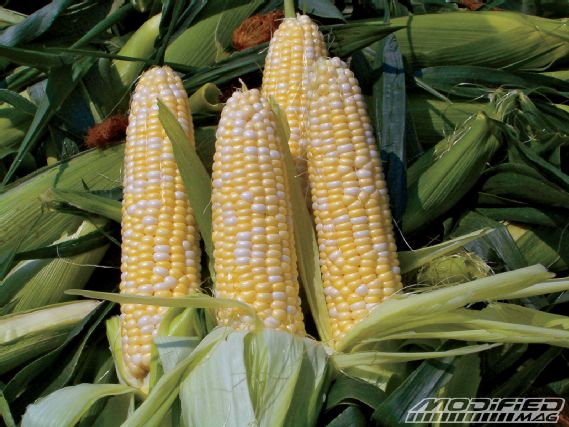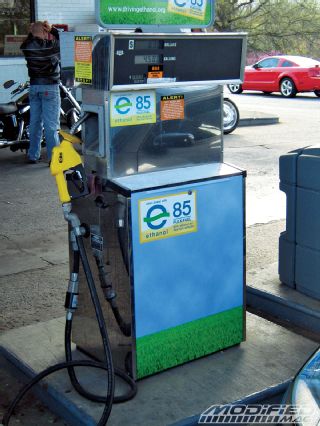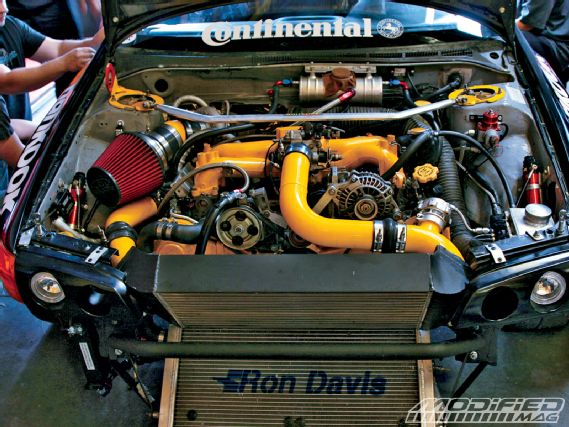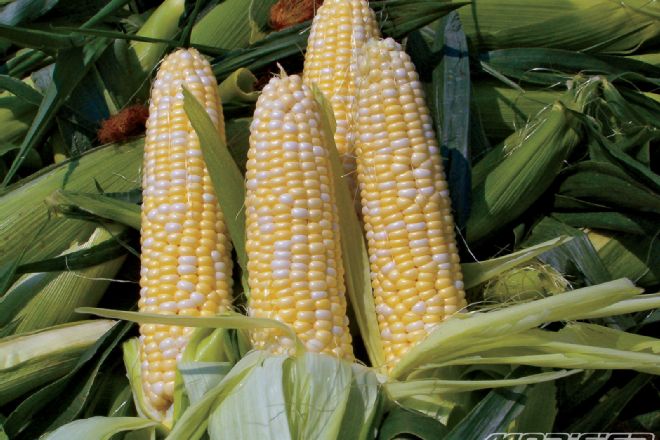Do a quick Google search on ethanol and you'll find yourself buried in a mountain of information from various perspectives. The Corn Growers of America want you to believe that ethanol-an alcohol derived primarily from corn that's mixed in with regular gasoline-is the solution to all of our environmental, economic and political problems. Automakers building Flex Fuel vehicles, which can run on as much as 85 percent ethanol (or E85, as it's labeled at the pump), also want you to believe that ethanol is the way of the future. Truth be told, there are significant pros and cons to the use of ethanol as an automotive fuel source, but from a tuner's perspective the upside appears to far outweigh the downside, given that some of the top go-fast shops in the nation are converting their fastest and most powerful machines to run on E85. So what are the pros and cons of ethanol and why are shops like GST Motorsports converting their legendary time attack Subaru Impreza L to it? Read on.
 |
It may look tasty, but turn it into ethanol and corn is both a renewable fuel source and a tuner's delight, given the cooling effects on the air/fuel mix in the combustion chamber.
|
It may look tasty, but turn it into ethanol and corn is both a renewable fuel source and a tuner's delight, given the cooling effects on the air/fuel mix in the combustion chamber.
Whether you're aware of it or not, you're probably putting an ethanol-blended fuel in your car every time you fill up; more than 50 percent of the nation's fuel supply has up to 10 percent ethanol content (or "E10")and has been blended into pump gas for decades. The main reason ethanol is being blended into pump gas is that it's being mandated by the government as part of a "renewable resource" strategy. But it's also being blended into more and more of the gas you can buy at the pump because it increases octane to gasoline, which helps protect against engine knock and can even improve engine performance if it's tuned to take advantage of the increased octane level. Ethanol also helps keep fuel injectors clean, plus it may lower the level of exhaust emissions, though this is a hotly debated topic.
Some studies have shown that ethanol can reduce carbon monoxide emissions by as much as 30 percent, reduce volatile organic compounds (VOC) emissions by up to 12 percent and reduce particulate matter (PM) emissions by more than 25 percent, while other studies have shown that there is no emissions advantage conferred by ethanol-or worse, that ethanol-blended fuels increase ozone and particulate emissions and contribute significantly to global warming. Many governments and their research agencies continue to argue that producing ethanol produces fewer greenhouse gases when the entire production cycle, from gathering to refining to emissions, is taken into account, while some independent university-based researchers argue that much of the research on this topic doesn't account for the real-world fact that when agricultural land is used for fuel there is less land to grow food. This drives up food prices and leads to conversion of forests and native grasslands to grow food, which has severe greenhouse gas consequences.
 |
The jury still seems to be out on whether or not ethanol is a truly "green" energy source because it's unclear if the energy required to grow, harvest and convert corn into ethanol results in an overall reduction of greenhouse gas emissions compared to drilling for and refining fossil fuels.
|
The jury still seems to be out on whether or not ethanol is a truly "green" energy source because it's unclear if the energy required to grow, harvest and convert corn into ethanol results in an overall reduction of greenhouse gas emissions compared to drilling for and refining fossil fuels.
Although there doesn't appear to be a consensus about ethanol with respect to its overall impact on the environment, from a performance enthusiast's perspective there do appear to be real advantages to converting to E85, according to Mike Warfield from GST Motorsports. "From our testing with the readily available E85 fuel we now use in our time attack Impreza L, which is about 105 octane, we've found it's not quite as high a knock resistance as the 116 leaded race fuel we used to use. This might lead you to think that the car would have to be somewhat neutered with regards to power output, but what the ethanol really shines at doing is lowering the cooling charge temp," Mike continues, "allowing us to push the tune a lot harder. As a result, our power output numbers are as good if not better than what we were making with the leaded race gas, and interestingly, we found that with ethanol we are able to go beyond MBT [Minimum Best Timing, the lowest value of ignition advance that produces maximum power] without the motor knocking. Obviously, this is not something you would want to do, but on 116 race gas we would actually run out of effective knock prevention prior to reaching MBT, so being able to go beyond MBT with ethanol really illustrates its charge cooling properties."
 |
Although it's not widely available at the pump yet, in time E85 (85 percent ethanol-based fuel) should be something you can fill your tank with conveniently and at a much lower cost than high-octane race gas.
|
Although it's not widely available at the pump yet, in time E85 (85 percent ethanol-based fuel) should be something you can fill your tank with conveniently and at a much lower cost than high-octane race gas.
When I asked Mike what sort of cars he felt would benefit the most from converting to E85, here's what he had to say: "I think the biggest gains to be had would be seen on forced induction cars, where the effective octane rating and cooling charge properties of ethanol can really shine. With a normally aspirated car, there will be some gains when tuned for E85, but not as significant as the gains with forced induction applications [because there's so much more heat generated by a turbo setup]. For modified street cars, whether or not it makes sense to convert to E85 is going to depend on intended use. If the car is being used to commute 50 to 60 miles per day and driven hard on weekends, you have to decide if the power increase is going to be worth it, given that your engine will consume about 30 percent more E85 getting from point A to point B. The other issue is simple availability. Locally we have two stations that carry E85 and they are about 45 miles apart and the next closest station is over 110 miles away, so until more stations start to carry E85 the availability issue will be a major factor when deciding to convert to it or not." It's also important to keep in mind that switching to E85 on an engine designed for standard pump gas will likely result in premature wear on its seals and piston rings, so converting a daily driver is probably not a good idea.
 |
GST's corn-powered Impreza L is one of the fastest time attack machines in the country. Orville Redenbacher, eat your heart out!
|
GST's corn-powered Impreza L is one of the fastest time attack machines in the country. Orville Redenbacher, eat your heart out!
But for weekend warriors who want a better performing fuel in their tank, especially for high-horsepower boost junkies who can really benefit from the cooler combustion temps associated with ethanol, converting to E85 makes a lot of sense. According to Mike, "With our race car we have seen our fuel costs go down substantially, with our weekend fuel bill now roughly a third of what we used to spend when running 116, which is huge for us given we're a self-funded team."
Reduced fuel costs and lower intake charge temps sounds like a winning combo, but what sort of modifications are required to make a car E85-ready? According to Mike, "There are some obvious issues that are expected with a fuel that requires roughly 30 percent more flow rate, so the first thing we do is work out the anticipated horsepower output of the car we're working with and match the fuel system accordingly. For example, with our time attack car we used to make around 500 whp on our Mustang dyno using Sunoco race fuel (C16 equivalent) and used RC Engineering 1,000cc injectors coupled to our main pump from our surge tank that was a Bosch Motorsports 044. With our first attempt with the E85, we upped the injectors to RC Engineering 1,600cc units and let the car fly on the dyno, where we saw fuel pressure dropping off at around 6000 rpm. After some testing, we found that we had maxed out the flow rate of the Bosch fuel pump, so we added another one running parallel with the existing unit. This allowed us to maintain the fuel pressure and tune the car to around 560 whp on our dyno."
 |
GST's 2.6-liter EJ25 turbocharged engine pumps out 560 whp on E85, thanks in part to the more aggressive ignition mapping this fuel's charge cooling properties allow.
|
GST's 2.6-liter EJ25 turbocharged engine pumps out 560 whp on E85, thanks in part to the more aggressive ignition mapping this fuel's charge cooling properties allow.
When I asked Mike if they had any unexpected surprises come up while converting their Impreza to E85, here's what he reported: "The biggest surprise came from the cleaning properties of the E85 fuel itself. The strong ethanol mix loosens up a lot of dirt and carbon deposits in the engine, which clogs the fuel filter. So now we run a couple of gallons of E85 through the system when converting to it and then change all the fuel filters. We also learned that with fuel cells like those used in our time attack car, depending on how old the cell is, the sealants used in the bladder design will break down, so you need to have your bladder sent off to the cell manufacturer to be updated to support the running of ethanol. We have not seen any issues with cars running the stock tanks."
With many of the fastest teams from this year's Modified Tuner Shootout running E85, including defending champion GST Motorsports in its awesome GC Impreza L, it's clear that this corn-based fuel has some real performance advantages over traditional race gas. Whether or not it's worthwhile for you to convert your car for E85 will depend on a lot of factors, some already outlined by Mike from GST, but it certainly appears that from a cost and power output standpoint, if you've got a turbocharged track car, E85 may just be that winning edge you've been looking for. As you'll see later in this issue, it hasn't hurt GST's Impreza any, that's for sure!
Send your feedback to [email protected].

